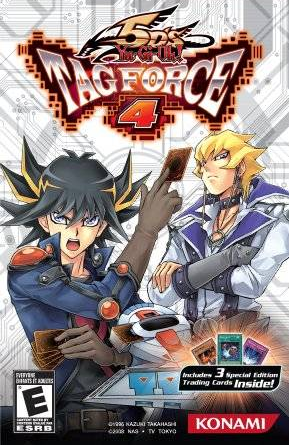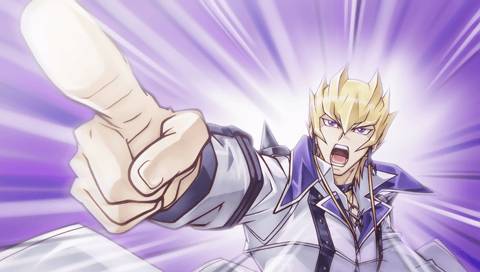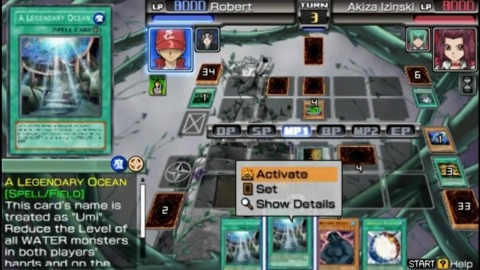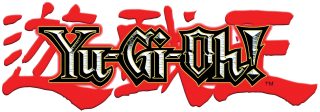
*So I am in the middle of a Yu-Gi-Oh! binge, and I figured that I don’t want to let this enthusiasm go to waste. Therefore, I am going to try and write a few blog posts about certain games from that franchise that I have fond memories of. I am also writing under the assumption that you, dear reader, have the basic rules of the Yu-Gi-Oh! Trading Card Game down pat up to around 2008 – the 5Ds cycle and the advent of Synchro Monsters and Synchro Summoning. In this post, I’ll be looking back at Yu-Gi-Oh! Tag Force 4 for the PSP. But a lot of what made this game memorable for me could be applied to other Tag Force games.*
If you watched enough of the Yu-Gi-Oh! anime series (any of them, honestly), you’ll run into episodes where characters engage in tag duels – 2 players alternating their turns against another pair doing the same. A precursor to this format came all the way back in the Duelist Kingdom Arc, where Yugi and Joey played a very modified version of Duel Monsters against the Paradox Brothers. Then we need to wait until the Battle City storyline where Yugi and Kaiba fought against Lumis and Umbra for a tag duel that is much closer to how the non-anime version of Yu-Gi-Oh! Plays. Maybe these duels are written into the story to explore a dynamic between two characters; are they polar opposites who must learn to work together? Or is this a chance to show the unshakeable bond between two people who can overcome any and all obstacles together? Or maybe in the case of 2 vs. 1 duels (like Yugi and Kaiba versus Dartz in Waking the Dragons), a tag duel is a way to show how one character is so dang powerful that two opponents are needed just to keep up.
But when it comes to players like me, tag dueling is far less common than the usual 1 on 1 format. This is where the YGO Tag Force series, beginning in 2006 and ending at around 2015, sets itself apart. As someone who sank many hours into Tag Force 4 (and had some brief excursions into TF 1 and 2), I found it to be a welcome change of pace from other Yu-Gi-Oh! game series I played. The character and story writing has its moments, though the real joy comes from working together with my AI partner to triumph against progressively harder enemies.
From personal experience, the general game flow of Tag Force 4 feels similar enough to its predecessors. To summarize the game’s genre, it is the Yu-Gi-Oh! card game plus a watered-down relationship sim. You are a duelist MC who moves around an overworld to interact with (and duel against) an assortment of nondescript NPCs and characters from the Yu-Gi-Oh! 5Ds anime. Like other video games from that franchise, you progress by defeating the starting roster of opponents to gain currency reserved for buying booster packs; then you use those new cards to beef up your deck to take on the next tier of duelists, leading to booster packs for better cards and the next set of harder enemies and so on.

UNLIKE most of those other video games, you can choose to partner up with those same opponents you defeated to engage in a Tag Duel against two other characters (more on that later. Partnering up with characters is also a prerequisite to access certain booster packs). Regardless of how you go about playing the game, you will gain the trust and affection of the duelists you defeated and/or worked with; this is represented with a slowly filling heart meter that could be further bolstered by gifting them items or playing some mini-games disguised as dialogue options. Hitting one of four relationship thresholds for a character (even the non-anime ones) triggers an event where you must help that person with some request or another; all of these episodes resolve with a duel, usually a tag duel putting you and that character on the same team.
Hitting the max relationship rank with a duelist ends in you getting copies of their signature card - that you could not access anywhere else in the game - plus a declaration of deep-friendship-or-love to signify the bond your MC has with that character. You can then continue the game to build up your relationships with other duelists, while characters you share a strong connection with remain in the overworld if you ever want to see them again. They would come up to you and ask to partner up rather than the other way around, and they would even gift you some cards or items if they see you teaming up with someone else.
The relationship events for 5Ds’ main protagonists are rough adaptations of that anime’s Dark Signer arc. That is, you’re going to help those guys save the world from an impending apocalypse perpetuated by the titular Dark Signers. These condensed versions of that storyline are decent enough, even if they lacked the emotional depth of the anime which really makes you care about the character struggles of the protagonists. But outside of those narratives, I have to say that there is a disappointing lack of detail when it comes to fleshing out character dynamics outside of those events. When you move around the overworld with a character from the anime, this partner would say most of the same dialogue towards all other characters you interact with – including those who share a personal connection or history with. For example, there is this classist, mean-spirited police officer named Tetsu Trudge whose entire storyline is about hunting down Yusei Fudo, the main character of Yu-Gi-Oh! 5Ds. Even watching the first episode of the anime reveals the highly hostile relationship between the two. But bringing them together in the overworld does not lead to unique dialogue or the like. There are other examples of that sort of narrative dissonance - Yusei and Jack, Misty towards Akiza, Leo and Luna and so on - that I will chalk down to laziness more than anything else.
It’s not all bad, however. On the positive side, I give credit to Tag Force 4’s attempt to flesh out the show’s minor characters. It’s fascinating to see what decks the game gives them – especially when those characters were never shown to have dueled on-screen. Furthermore, their relationship events are more interesting just by virtue of you not knowing how their stories would unfold. And given the top-heaviness of the anime plot, where only a small minority of main characters get the lion’s share of wins and (admittedly well written!) character development, it is a tad bit refreshing to see someone else be the story’s hero of the day for a change. And if the game doesn’t do justice to the relationship between characters outside of events, at least it does a better job of showing how your MC is getting closer with the duelists they interact with. As you slowly fill up the heart meters, the dialogue from the mini-games also changes to reflect that developing closeness. Characters start to open up about themselves or admit other things going on in their lives. And your exchanges with those you are familiar with are intimate more often – maybe even romantic.

So, the game does a passable job of making me care about its characters – some more than others. But the novelty of Tag Force 4 (and by extension the series it is from) comes from the dueling format. The changes feel so simple – you are alternating turns with your teammate while sharing the same zones and graveyard – but the implications that come from those tweaks change the experience of dueling in a meaningful way. The simple mechanic of ‘bouncing’ a card from the field back to its owner’s hand (through effects like Hane-Hane, Giant Trunade or Penguin Soldier) turns from a minor inconvenience to a major hindrance. Rather than just waiting for one opponent to finish their turn to play that bounced card again like in a 1 vs 1 duel (which are still possible in Tag Force games), its owner now needs to wait on three other players and their turns (the two opponents and one teammate) before doing so. Effects like Giant Rat, UFO Turtle, Shining Angel and so on that help a duelist find certain monsters or cards may be valuable for one character. But that powerful benefit can whiff if it activates on the turn of the other teammate whose deck lacks the search targets for those tutors. You can theoretically set spell cards face down as a way to ‘give’ your teammate an extra card to be used on their turn, but the duo opposite you can then counteract this by using spell removal cards.
I took joy from noticing and taking advantage of these little nuances in a tag duel, but the real fun comes from realizing the most important difference between a normal duel and its tag team version: to really go far in either the available tournaments in this game - or even the relationship events - the deck you play should synergize with that of your teammate. A stall-and-burn deck with cards like Gravity Bind or Level Limit B, no matter how well built or carefully thought out, could flop if working alongside a beatdown counterpart. A player who counts on Solidarity as a reliable source of bonus attack points (which only triggers if all monsters in the graveyard share the same type) faces a major hurdle if the tag partner plays monsters of a different type. Or maybe two decks clash because they really count on getting their field spells out in play to function (say, A Legendary Ocean Water deck alongside a Zombie World deck). Don’t get me wrong; powerful decks that bear no relation to what your teammate wants to do could win the day. It’s just that the margin for error is far smaller, since the best duelist out of the four need to worry about two opponents (and decks) trying to counteract their board rather than the usual one.
So unsurprisingly, the very format of the tag duel can alter the way you build your deck – or the way you build your partner’s deck, which is only possible after you finish two relationship events with that character. You can edit your teammates’ deck to contain (or even just splash) the archetypal cards that you run; this was how I initially approached deckbuilding, when I was particularly wedded to playing the Gladiator Beasts. But in my more recent dive into Tag Force, I really made it a priority to build my deck around what my teammate runs while refining what said teammate was trying to do. It’s this shift that helped me appreciate the breadth of strategies and archetypes that were available by 2009. Leo runs a Morphtronics deck, Yusei relies on Synchro summoning on top of an assortment of warriors, Jack plays dragon-themed beatdown and so on. Even between stall-and-burn characters like Luna and Rally, the latter specializes with burn damage while the former achieves the same effect with cards that reverse enemy life point gains (that she deliberately provides) with combos like Gift Card into Bad Reaction to Simochi. I am not suggesting that these strategies are equally matched against one another. But I enjoyed that challenge of being, say, a Reptile Solidarity duelist with Misty in one game before shifting over to a swarming Blackwing build to work alongside Crow. This wider perspective really helps me appreciate what the Duel Monsters card game has to offer in the late 2000s. There is also a joy that comes from reading your teammates’ various deck recipes, thinking up ways to make them even better, and seeing those improvements play out in duels.

And that variety of cards, archetypes, and strategies is evident in Tag Force 4, which contributes to the game’s incredible replay value. It’s not just an expanding roster of characters who you can duel against or work with. It’s that each character packs multiple decks each, so encounters against them can be different even if your deck stayed the same. Hell, a few characters even have different versions of themselves that can be unlocked after fulfilling certain thresholds. For example, you can unlock Misty’s Dark Signer version after maxing out your relationship with her AND defeating Akiza a certain number of times. So if you are already enjoying the core experience of Tag Force 4, then you could expect to keep playing it for a good long while.
I also want to give some credit to the game’s presentation in both the visual and audio fronts. Like in other Tag Force games, duels are punctuated with animations of characters playing their cards and reacting to the pushes and pulls of the contest. They express surprise when their key cards get removed from the field, have various chants or quips whenever they Synchro Summon, engage in some banter when they’re ahead/behind and so on. Some ace monsters tied to the anime characters like Yusei’s Junk Warrior, Jack’s Red Dragon Archfield and Akiza’s Black Rose Dragon also have two cutscenes each: one for when they’re summoned onto the field, and another for when they attack. Admittedly, these animations do cause duels to take longer than otherwise (which is why there is the option to skip those scenes entirely). But honestly, I really appreciate how those sequences help immerse you in a duel. It’s honestly like watching an episode of the Yu-Gi-Oh! anime that your MC is involved in, with the possible excitement of a back-and-forth interaction between player to player - or team to team in tag duels. About the only negative I can ascribe to the animations is that they lack the voice acting from the Japanese version, which is a major omission in my humble opinion. The soundtrack of Tag Force 4 also has a few catchy tunes, especially the dueling music. Some of them have that techno tone that really meshes with the futuristic setting of Yu-Gi-Oh! 5Ds, and the tunes playing in the rundown Satellite are suitably grimy and melancholy. And like in other Yu-Gi-Oh! games outside of Tag Force, they shift depending on which player/team has the upper hand.
In terms of favorite tracks – in no particular order - I’d pick Clear Vision, On Cloud Nine, Deathmatch, Spellbound, and Critical Moment.
Of course, I want to take the time to address the game’s flaws beyond the lack of unique dialogue between characters. The AI (from your partner and from your opponents) can make some truly bone-headed decisions, and you have virtually no control over your teammate’s actions. Sometimes it activates spells to dispose of singular monsters that just don’t pose that much of a threat in the long term. In other instances, it walks into some painful traps by needlessly committing all available monsters to offense. The soundtrack that comes from editing your deck abruptly shifts to another without any rhyme or reason; I don’t think the new track is bad, but players of Tag Force 4 do not understand why this is happening to this very day. It can also be a hassle to track down specific duelists, especially if said duelists are not characters in the 5Ds anime. And while there is a tutorial for players who aren’t too familiar with the card game mechanics, it’s hard for me to say if it is effective as a teaching tool.
But despite these issues, Tag Force 4 is still an essential and enjoyable part of my experience with the Yu-Gi-Oh! franchise. Tag duels are a fun and interesting variation to the card game, and there is just enough story and character writing to keep me invested. At the bare minimum, I hope to try out the older Tag Force 2 in the future and see how it differs from TF 4. But with how much time I’m sinking into the latter, it’s going to be a bit until that actually happens...

Log in to comment